Comprehensive Guide to iPhone 12 Dimensions and Design

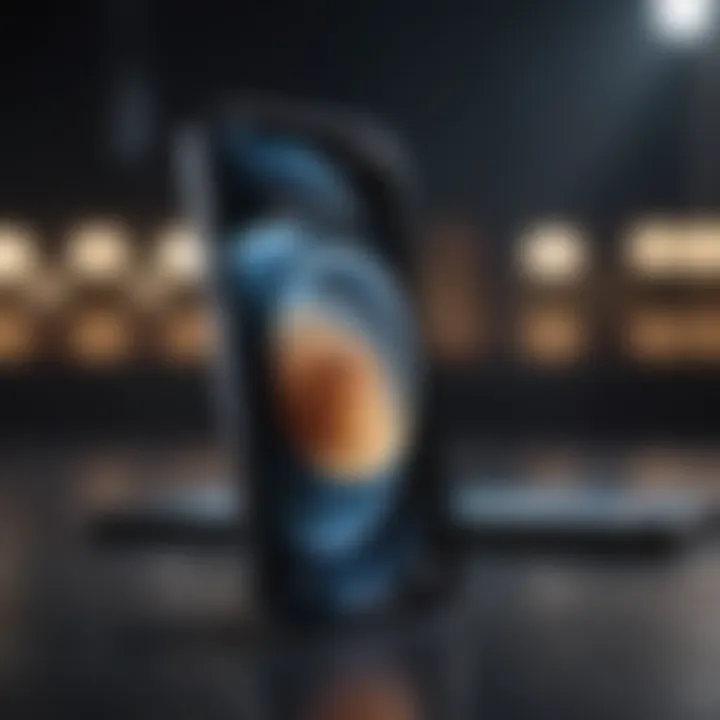
Product Overview
Preamble to the Apple product being discussed
The iPhone 12, released in October 2020, marked a significant milestone in Apple's smartphone lineup. Known for its robust design and advanced features, the iPhone 12 has made an impact on both casual users and tech enthusiasts. At first glance, its design captures attention with a sleek and flat-edge aesthetic that distinguishes it from previous models.
Key features and specifications
The dimensions of the iPhone 12 contribute to its usability and portability. It measures 146.7 mm in height, 71.5 mm in width, and 7.4 mm in thickness. With a weight of 164 grams, it is lightweight, allowing for easy one-handed operation.
In terms of display, it is equipped with a 6.1-inch Super Retina XDR display, enhancing the overall user experience. The resolution is 2532 x 1170 pixels, which provides impressive clarity and color accuracy.
Design and aesthetics
Apple focused on blending function with form in the iPhone 12. The device sports an aluminum and glass frame, offering both elegance and durability. Apple introduced Ceramic Shield technology, which enhances screen toughness, allegedly making it four times more resistant to drops. The available colors — black, white, red, green, and blue — further appeal to a diverse audience, letting users express personal style.
Performance and User Experience
Performance benchmarks
The iPhone 12 is powered by the A14 Bionic chip, the first 5-nanometer chip in the smartphone industry. This results in faster computational speed and better energy efficiency. Users have reported enhanced performance in demanding applications and while multitasking.
User interface and software capabilities
Operating on iOS 14 out of the box, the iPhone 12 provides a user-friendly interface. Features such as Widgets and App Clips improve user interaction with the phone. Moreover, the integration of 5G technology ensures smoother browsing and streaming capabilities, appealing to those who rely on their devices for high-speed internet.
User experiences and feedback
General feedback from users highlights how the dimensions of the iPhone 12 contribute to its ergonomic design. Many find it comfortable to hold and operate, particularly in comparison to bulkier models. Reviews often point out the responsiveness of the touch screen and the vividness of the display, making it suitable for gaming, photography, and other multimedia tasks.
Comparison with Previous Models or Competitors
Advancements and improvements from previous models
Compared to the iPhone 11, the iPhone 12 offers a noticeable upgrade in design and performance. Its slimmer profile and better display technology have been well received. Transitioning to 5G capability also sets the iPhone 12 apart from its predecessor.
Competitive analysis with other similar products
In the competitive landscape, devices like Samsung Galaxy S21 have similar dimensions and features. However, the seamless integration of hardware and software in Apple's ecosystem often gives it a distinctive edge. This is particularly appealing for users who value brand loyalty and consistent updates.
Value proposition
The iPhone 12 falls within a competitive price range. Given its premium build quality, innovative features, and Apple's ongoing support, many users find it to be a worthwhile investment in the realm of smartphones.
Tips and Tricks
How-to guides and tutorials for optimizing the Apple product's performance
To maximize the iPhone 12’s performance, users should regularly update their software. Keeping applications optimized and removing unused apps can also help in maintaining swift operation.
Hidden features and functionalities
Many users are unaware of the dark mode feature, which not only enhances aesthetics but also conserves battery life. Additionally, the camera allows for adjustments in composition through grid settings, improving photography skills.
Troubleshooting common issues
Common issues include battery draining quickly or connectivity problems. Restarting the device often resolves minor glitches. If problems persist, resetting network settings may provide a solution.
Latest Updates and News
Recent developments in software updates and new features
Apple consistently rolls out software updates to enhance the iPhone 12's functionality. The recent updates have added features like improved privacy settings and enhanced messaging capabilities.
Industry news and rumors surrounding upcoming products
Speculation regarding future iPhone releases continues to intrigue users. Rumors suggest advancements in camera technology and possibly foldable designs in future models.
Events and announcements from Apple
Apple holds various events each year to announce new products. These events often include updates on existing devices, shedding light on how they fit within Apple's broader ecosystem.


By examining the dimensions and design aspects of the iPhone 12, users can better appreciate how these elements contribute to its overall performance and usability. Thus, this article not only highlights the importance of size and shape but also relates them to user experience in a practical context.
For further information about the iPhone 12, visit Wikipedia.
Read more on Reddit to join discussions about iPhone experiences.
For updates on Apple's latest news, check out Facebook.
Prologue
An important aspect to consider is how the dimensions of the iPhone 12 cater to ergonomics. A device that is easy to hold and use enhances the overall experience. This aspect becomes even more pertinent in today's context, where smartphones are not just communication tools but integral parts of daily life.
Moreover, the interplay between physical characteristics and usability cannot be ignored. Larger screens offer better visibility, but they can also complicate one-handed use. By analyzing the iPhone 12’s dimensions, users can make informed choices about whether this phone meets their needs.
The growth of the smartphone market has also changed user expectations. As consumers become more discerning, they expect not just specifications but also thoughtful design that enhances daily use. The dimensions of the iPhone 12 are part of a larger narrative that reflects trends in the smartphone industry.
In addition, understanding the dimensions opens insights into accessory compatibility. Cases and screen protectors need to align with the specific size of the phone. A deeper look into these elements presents valuable information for potential buyers, helping them make the best choice.
Therefore, this introduction sets the stage for a detailed exploration of the iPhone 12's dimensions. By dissecting various aspects of its design, we aim to provide Apple aficionados and tech enthusiasts with a thorough perspective, aiding their decision-making processes.
Historical Context of iPhone Dimensions
Understanding the historical context of smartphone dimensions is essential to appreciate the development of the iPhone 12. This section highlights several key elements, including how and why dimensions have changed over time, as well as the implications these changes hold for consumers and the tech industry.
Evolution of iPhone Sizes
The journey of iPhone sizes began with the first-generation iPhone, launched in 2007. It had a relatively compact size with a 3.5-inch screen. As users started to prefer larger displays for better media consumption and browsing experiences, Apple adapted accordingly. Gradually, models like the iPhone 6 and 6 Plus introduced larger screens measuring 4.7 inches and 5.5 inches, respectively. The trend has continued with subsequent releases.
Initially, the transition to larger sizes was met with apprehension. Users worried about the practicality of one-handed use. However, Apple carefully balanced design and functionality. Each new model addressed previous concerns while introducing advancements. The iPhone 11, for instance, featured a 6.1-inch display without making the device cumbersome. This evolution demonstrates how Apple has prioritized user preferences and market trends.
Moreover, the iPhone 12 marked another significant shift. With a 6.1-inch display, the device maintained the size introduced with the iPhone 11 but changed the design ethos. The flat edges and more industrial look brought a refreshing aesthetic. The materials and screen technology used further enhanced the device, making it not just bigger but also more appealing in terms of user experience.
Comparison with Previous Models
When we analyze the iPhone 12’s dimensions in comparison to its predecessors, trends become clear. For example, the iPhone 12 is taller and slightly wider than the iPhone 11, yet, the overall thickness has been reduced when compared to the iPhone 11 series. This demarcation is essential, as it illustrates Apple's effort to innovate while remaining consistent in hardware dimensions.
Users often compare models when considering an upgrade. For instance, while the iPhone 12 might seem similar to the 11, factors like weight, feel, and ease of handling play a crucial role. The shift to lighter materials has noticeably changed the user experience. Consumers prioritize comfort and usability, and the iPhone 12 delivers on both fronts.
In the grand scheme, the dimensions of the iPhone 12 not only reflect Apple’s design philosophy but also reveal user preferences over time. The company’s focus on creating a device that is both aesthetically pleasing and user-friendly has been pivotal in maintaining its position in the competitive smartphone market. This historical awareness allows consumers and tech enthusiasts to appreciate the deliberate choices made in the iPhone 12's design.
Technical Specifications of iPhone
Understanding the technical specifications of the iPhone 12 is essential for grasping its overall performance and usability. This section will extensively review key elements such as dimensions, weight, and build materials. By defining these specifications, users can assess how the device's form factors integrate into their daily lives. Specific details matter when it comes to device selection, especially in a competitive smartphone market.
Dimensions Overview
The iPhone 12 presents a distinct size profile, measuring 146.7 mm in height, 71.5 mm in width, and 7.4 mm in thickness. These dimensions contribute to its aesthetic appeal. The design philosophy emphasizes symmetry, which aligns well with the device's display area. The screen size is 6.1 inches diagonally, providing a large surface area while keeping the phone easy to hold. This balance is a critical consideration when weighing the device’s usability. A sleek design must also allow for convenience in daily handling.
Apple’s choice of these dimensions is not arbitrary. It relates to the demand for functionality alongside style. Users expect a device that is not only powerful but also fits comfortably in their hands. The slim profile of the iPhone 12 allows for ease of carrying and use. In a world increasingly dominated by smart devices, the size of the iPhone 12 caters to a better user experience.
Weight and Build Materials
The iPhone 12 weighs approximately 164 grams. This weight is relatively light compared to competitor devices with similar features. The build materials are also crucial to the device's appeal. Apple utilizes aerospace-grade aluminum for the frame, along with a glass back that is both robust and attractive. This combination results in a sturdy feel that conveys luxury.
The material choice influences not only the look but also the functionality of the device. The glass back supports wireless charging, a feature that has become a necessity for many users. Additionally, the choice of materials suggests an emphasis on durability while keeping the overall weight manageable.
Users should consider how weight affects portability. A lighter device is more appealing for daily tasks, especially for those using their phone extensively throughout the day. Apple's attention to detail in these technical specifications reiterates their commitment to producing high-quality products.
"When evaluating smartphones, weigh the importance of size and materials. The iPhone 12 exemplifies the marriage of sophistication and functionality."
In summary, the dimensions and weight of the iPhone 12 play a significant role in its usability. Consumers can expect a carefully crafted device that not only fits well within their hands but also offers features aligning with modern lifestyle demands. Understanding these technical specifications lays a foundation for further discussions about performance and user experience.
Physical Dimensions of the iPhone
Understanding the physical dimensions of the iPhone 12 is crucial, as it affects user experience, ergonomics, and accessory compatibility. The design choices Apple made influence how comfortable the device is for daily use as well as its overall functionality. Dimensions not only tell users about the size but also about how well it fits into their lifestyle.
The height, width, and thickness of the iPhone 12 plays an important role in these considerations. Each of these elements contributes to the handling, portability, and usability of the device. As smartphones become increasingly integrated into daily life, the impact of dimension metrics, such as grip ability and one-handed use, has gained importance among consumers and experts alike.
Height and Width Explained
When examining the height and width of the iPhone 12, it measures 146.7 mm and 71.5 mm respectively. These dimensions allow the phone to balance usability with portability. The height is adequate for users to enjoy multimedia content without feeling cramped, while the width provides a comfortable grip.
This aspect of the design is significant for performing various tasks. For instance:
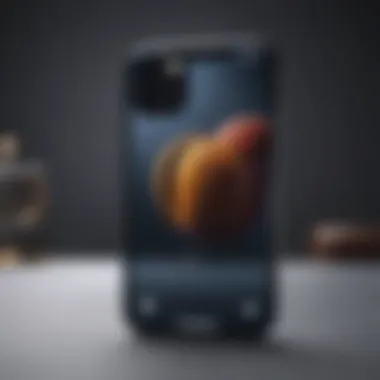
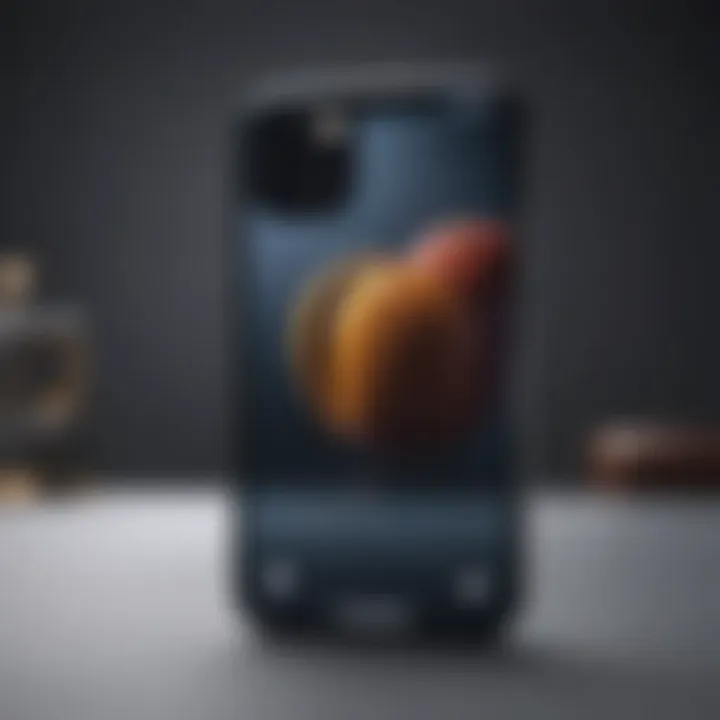
- Typing: A wider surface means that users can type with more accuracy.
- Viewing: The dimensions facilitate a comfortable viewing experience while watching videos or browsing the internet.
- Accessibility: Users with larger hands may find the width beneficial for navigation and operation.
The dimensions also increase ease when using protective cases. Most designs available in the market align well with the established height and width, creating a snug fit that does not compromise accessibility.
Thickness and Its Implications
Thickness is another vital aspect when assessing the iPhone 12. At 7.4 mm, it strikes a balance between sleek design and structural integrity. A thinner device may appeal aesthetically but can compromise durability, whereas a thicker model might feel clunky and harder to handle.
The iPhone 12’s thickness provides several implications:
- Portability: A relatively slim profile allows for easy sliding into pockets or bags.
- Durability: Despite being thin, Apple has ensured that the materials used offer sufficient protection against drops.
- Accessory Compatibility: This thickness ensures a more universal compatibility with accessories such as cases and wireless chargers, as they are designed to accommodate such specifications.
Impact of Dimensions on Usability
The dimensions of the iPhone 12 significantly influence its usability, shaping interactions and experiences. A device's size and weight can determine how comfortably it can be held, operated, and stored. When considering the user’s daily activities, from texting to gaming, the physical design emerges as a crucial factor that can enhance or hinder performance.
Grip and Ergonomics
Grip and ergonomics pertain to how well a device fits within the user's hand. With the iPhone 12, the choice of dimensions plays an essential role in delivering a comfortable hold. The flat edges, a departure from the rounded forms of earlier models, provide additional surface area for users to grasp securely. This feature not only enhances comfort but also allows for improved stability when handling the device.
A few critical aspects include:
- Width and Shape: The iPhone 12's width is balanced, making it suitable for most hand sizes. Users report that the flat-sided form is easier to handle than its predecessors.
- Material: The aluminum and glass construction offers a solid yet light feel. This effect means that users experience less fatigue during prolonged use.
- Weight Distribution: The iPhone 12 weighs approximately 164 grams, providing a lightweight experience. This inventive balance makes it feel less cumbersome while ensuring it doesn’t slide easily from the hand.
One-Handed Use Considerations
One-handed use remains a priority for many smartphone users today. The dimensions of the iPhone 12 cater to this demand, particularly for users with smaller hands. The screen size is optimized to ensure that everything remains within a thumb’s reach while holding the device.
Factors influencing one-handed operation include:
- Screen Size: The 6.1-inch screen strikes a balance between viewing comfort and the ability to navigate with a single hand. This size allows for easy access to apps and features.
- Software Modifications: Various features in the iOS system further support one-handed use. The reachability function, for instance, lets the user easily access the top of the screen without needing both hands.
- Practicality: During situations like walking or multitasking, the usability of a smartphone decreases when it requires two hands. The iPhone 12’s design mitigates this issue, making it more practical for everyday scenarios.
The user experience is often dictated by the capability to handle the device comfortably and effortlessly. Good ergonomics and size play a vital role in this effective interaction.
In summary, the iPhone 12's dimensions have been thoughtfully designed with usability in mind. From facilitating a secure grip to enhancing one-handed operation, the physical characteristics of the device enhance the overall user experience.
Display Characteristics
The display characteristics of the iPhone 12 are crucial in understanding its usability and overall appeal. From resolution to screen size, each factor plays a significant role in how users interact with the device. Given that a smartphone's screen is the primary interface for most users, the importance of these characteristics cannot be overstated. The iPhone 12 boasts a Super Retina XDR display, which enhances the visual experience through its vivid colors and high contrast. This makes content consumption more enjoyable and immersive.
Screen Size and Resolution
The iPhone 12 features a 6.1-inch screen size, which sits comfortably between larger smartphones and compact devices. This size strikes a balance, allowing for a spacious viewing area without sacrificing portability.
In terms of resolution, the display delivers 2532 x 1170 pixels, equating to approximately 460 pixels per inch. Such a high resolution ensures clarity in images and text, making reading or watching videos a pleasant experience. Furthermore, the OLED technology used in this display contributes to deeper blacks and more vibrant colors, which enhance the overall viewing experience. The inclusion of HDR support allows users to enjoy content that is encoded with High Dynamic Range, which provides a more stunning display for films and photos.
Impact of Size on User Experience
The dimension of the iPhone 12 screen significantly impacts how users engage with their devices. A larger screen facilitates easier multitasking, as users can view multiple apps side by side. For example, using the Messages app alongside a web browser becomes more manageable on this screen size.
The viewing angles are also a key consideration.
- Comfort: With a screen of this scale, textual content remains legible without zooming in, which can reduce strain on the eyes.
- Interaction: The touch sensitivity of the display enhances the responsiveness when swiping or tapping, making the overall experience fluid and swift.
However, it is worth noting that there are challenges. Users with smaller hands may find extensive one-handed use less comfortable, especially when reaching for elements located in the top corners of the screen. Therefore, the size of the iPhone 12's display is a double-edged sword—it offers both usability benefits and potential drawbacks depending on user preference and hand size.
"The display is often the primary point of interaction for smartphone users, making its characteristics essential for user satisfaction and engagement."
Compatibility with Accessories
The compatibility of the iPhone 12 with accessories is a vital aspect that impacts its usability, durability, and overall user experience. This section will explore how the device's dimensions dictate what accessories can be utilized and how they enhance the functionality of the iPhone 12. Given the number of third-party and branded accessories available, understanding these compatibilities can help users make informed decisions while purchasing and using accessories for their phones.
A significant portion of the accessory market is dedicated to cases and covers, which protect smartphones from drops and scratches. Given the iPhone 12's specific dimensions, users must seek cases designed to fit its measurements accurately. The right case should not only be snug but also maintain easy access to buttons, charging ports, and camera lenses, which are all essential for a seamless user experience.
Cases and Covers
When it comes to cases and covers, the iPhone 12 offers various options tailored to its dimensions. Users can choose from slim cases, rugged cases, or wallet cases, each varying in protection level and style. Slim cases provide minimal bulk while safeguarding against scratches, appealing to those who prefer a lightweight device. On the other hand, rugged cases cater to users who seek enhanced protection for more demanding environments, such as construction sites or outdoor activities.
Moreover, cases can also provide additional functionality. For instance, certain models may include built-in card slots or stands, enhancing the phone's utility without necessitating extra gadgets. However, it is essential to note that using thicker cases can sometimes impede wireless charging capabilities, which many users appreciate for convenience.
Screen Protectors and Add-ons
Screen protectors are another crucial accessory for ensuring the longevity of the iPhone 12. With its glass front, the screen is susceptible to scratches and damage, making the usage of screen protectors a wise decision. There are various options, such as tempered glass and film protectors, each with distinct advantages. Tempered glass generally offers higher durability and maintains clarity, while film protectors are usually thinner and may provide a less noticeable appearance.
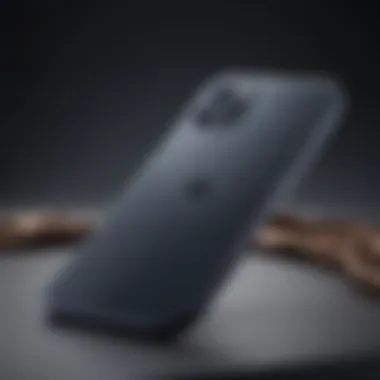
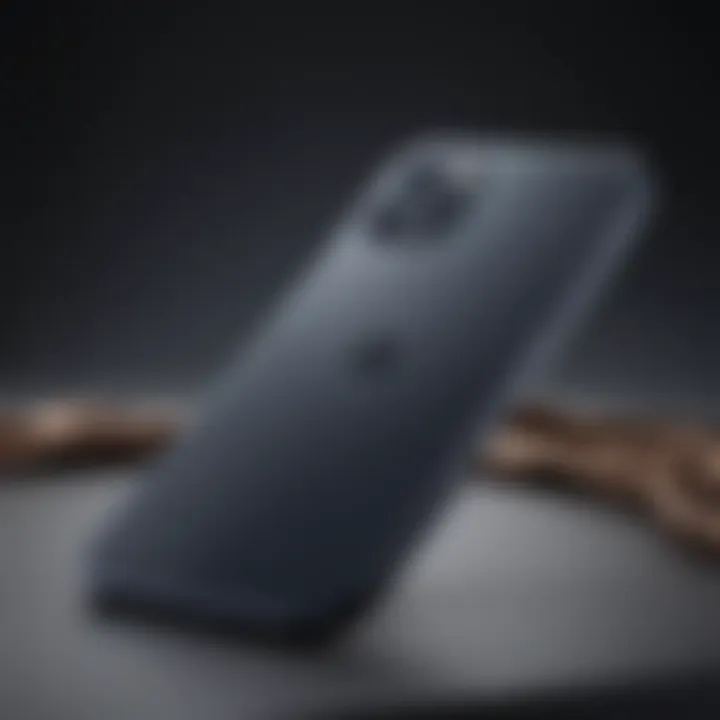
Additionally, many add-ons work in tandem with the iPhone 12’s dimensions. For instance, lens attachments and photography tools that enhance the camera experience can be considerable assets for photography enthusiasts. As these add-ons are often designed to be compact and lightweight, they complement the iPhone's design without adding unnecessary bulk.
In summary, compatibility with accessories including cases, covers, screen protectors, and additional tools is an integral aspect of the iPhone 12 experience. A user's choice of accessories can significantly affect usability, protecting the device while also enhancing its core functionalities. This awareness allows users, especially Apple aficionados and tech enthusiasts, to optimize their interactions with this smartphone.
Comparative Analysis with Competitor Models
Dimension Comparison with Android Smartphones
The smartphone market is diverse and teeming with competition. Analyzing dimensions of the iPhone 12 against various Android models reveals key differences and similarities in design philosophy. Android manufacturers like Samsung, Google, and OnePlus prioritize various attributes that can lead to distinct form factors. For instance:
- Samsung Galaxy S21 has a similar height but sports a wider body, which affects grip.
- Google Pixel 5 is lighter, leveraging its smaller frame, making it a choice for users who prioritize weight.
- OnePlus 9 emphasizes thinness, which may appeal to users who prefer sleek devices.
This comparison sheds light on how the iPhone 12 stacks against competitors. Dimensions impact not just aesthetics but also functionality—the ease of use in daily scenarios. Larger devices might appeal to media consumption, while smaller ones are often favored for portability. Understanding these contrasts helps users make informed decisions that align with their preferences.
Positioning in the Market
The positioning of the iPhone 12 in the competitive market is significant. Apple has carved a niche that balances premium features with robust design. The dimensions of the iPhone 12 are carefully curated to suggest elegance while ensuring utility. The following points illustrate its market positioning:
- Target Audience: Apple aims at users who value a blend of aesthetics and usability. The dimensions align with this by offering a device that feels substantial yet comfortable in hand.
- Design Language: The flat edges of the iPhone 12 offer a modern appeal, distinct from the rounded designs common in many Android counterpart devices. This aspect allows Apple to differentiate itself.
- Performance Perception: Users often correlate physical dimensions with performance capability. A well-proportioned device like the iPhone 12 conveys premium technology.
In summary, dimension analysis versus Android smartphones serves to emphasize not just the design but also the consumer demand within the market. The interplay of size and user experience is crucial to any smartphone’s success, echoing throughout Apple's strategy for the iPhone 12.
User Feedback on iPhone Dimensions
User feedback is vital in understanding the overall reception of the iPhone 12's dimensions. It offers insights into how design choices affect everyday use. While manufacturers focus on specifications, the users provide real-world experiences that highlight practical benefits and challenges. Gathering this feedback can guide future design innovations and improvements.
Positive Aspects Highlighted by Users
Many users appreciate the iPhone 12's balanced feel and weight distribution. Some key positive aspects included:
- Comfortable Grip: Users report that the dimensions allow for a secure grip, making it less likely to drop.
- Size: The screen size (6.1 inches) is seen as ideal for viewing without being too bulky. It strikes a balance between usability and portability.
- Ergonomic Design: Feedback indicates a preference for the flat edges, reminiscent of earlier models, which many find more comfortable to hold.
- Lightweight Nature: Users note that the iPhone 12 feels light in hand compared to its predecessors, enhancing overall usability.
"The iPhone 12 feels just right in my hand, not too heavy and not too big. I can easily use it one-handed for daily tasks."
Challenges and Criticisms
While there are many positive aspects, some challenges and criticisms have also emerged from user experiences. These include:
- Thickness Concerns: A portion of users mentioned that, while not excessively thick, it feels bulkier than certain competitors. This may impact prolonged one-handed use.
- Case Compatibility: As new dimension specifications were introduced, some older iPhone cases didn’t fit properly. Users expressed frustrations needing to purchase new accessories.
- Screen Size Limitations: Some users felt that for heavy media consumption, the display could use more width for an immersive experience.
Overall, user feedback serves as a critical element in shaping potential adjustments in future designs. Understanding both positive and negative experiences provides a more comprehensive view of the iPhone 12 dimensions and its practical implications in daily life.
Future Trends in Smartphone Dimensions
As the smartphone market continues to evolve, understanding the future trends in smartphone dimensions becomes paramount. This section explores how innovations, user preferences, and changing technological landscapes can influence the design of upcoming devices, including the next iterations of the iPhone.
New dimensions must cater to improved user experience and practical use. The slight changes in size and weight can significantly affect usability. Future trends in dimensions can impact ergonomics, battery capacity, and the type of components that can be integrated into devices.
Potential Innovations
Innovation in smartphone design is crucial for maintaining relevancy in a saturated market. Some potential innovations regarding dimensions include:
- Flexible Displays: The adoption of flexible display technologies could lead to foldable smartphones, drastically changing size and form factors. This offers users the appeal of larger screens without the added bulk when folded.
- Lightweight Materials: Advancements in materials science can significantly reduce the weight of devices. The use of materials like carbon fiber or advanced alloys can enhance strength while minimizing weight.
- Modular Designs: Users may prefer customizable dimensions and modular designs that allow them to adjust the shape or size according to their need, offering greater versatility in how the device is used or carried.
- Ergonomic Shapes: Future innovations may focus more on ergonomics. Rounded edges or contoured shapes could provide a more natural grip.
The implications of such innovations are vast. Devices become more appealing and practical while addressing user needs better than before.
Consumer Preferences Shaping Design
Consumer preferences play a critical role in forwarding smartphone designs. The demand for devices that are sleek yet functional continues to rise. Various factors influence these preferences:
- Portability: Modern users prioritize portability. This drives demand for thinner and lighter smartphones that fit comfortably in pockets or small bags.
- Usability Features: Features such as larger displays for media consumption must be balanced with usability. Users often desire larger screens but also prefer devices that can be handled easily with one hand.
- Sustainability: Increasing environmental awareness has users advocating for designs that minimize waste and use recyclable materials. Lens and casing designs might evolve to align with eco-friendly practices.
- Fashion Trends: The aesthetic appeal does not fall behind functionality. Users frequently search for stylish designs to match their personal brand or style preference.
Keeping an ear to the ground regarding these preferences is vital for any brand, especially one with a dedicated fanbase like Apple. Ignoring the changing consumer landscape can lead to missed opportunities in an increasingly competitive sector.
Epilogue
The conclusion of this article serves as a pivotal moment to emphasize the significance of the dimensions of the iPhone 12. Understanding these dimensions is far more than just a matter of numbers; it encapsulates a blend of usability, user experience, and the continuing evolution of smartphone design.
By delving into the specific elements of size, weight, and form factor, we uncover how these factors impact daily interactions with the device. For instance, the iPhone 12's height and width facilitate a manageable grip, which is essential for ergonomic use. In turn, this affects tasks like one-handed operation and overall comfort during extended use.
Furthermore, we explored compatibility with accessories, highlighting how the dimensions directly influence the availability and effectiveness of cases, covers, and screen protectors. This is crucial for consumers who prioritize device protection and personalization.
Moreover, the analysis of user feedback sheds light on the real-world implications of the iPhone 12's physical characteristics. Users offer invaluable insights into what aspects work well and where issues may arise. This first-hand data informs potential future designs and adjustments within Apple's product lineup.
"Understanding the dimensions of a device like the iPhone 12 not only enhances purchase decisions but also fosters a deeper appreciation for the engineering behind smartphone design."
Finally, the trends and preferences observed suggest that the market is shifting continuously, responding to consumer desires for sleeker and more functional devices. The synthesis of all this information not only concludes our inquiry into the iPhone 12 but also opens the door for future conversations about the trajectory of smartphone design in general.
Ultimately, a thorough understanding of the iPhone 12’s dimensions is an essential consideration for Apple aficionados, tech enthusiasts, and professionals in the industry. It informs choices, enhances usage experience, and contributes to future innovations.



